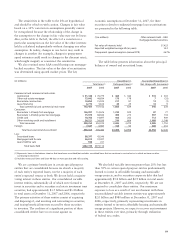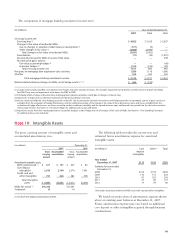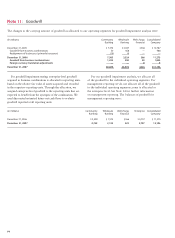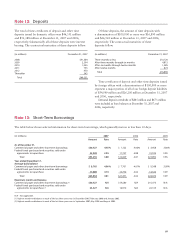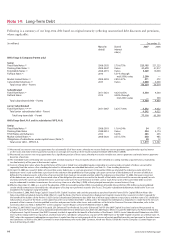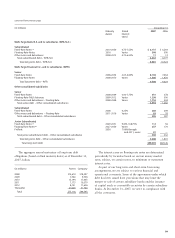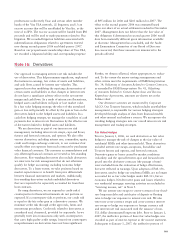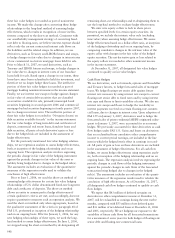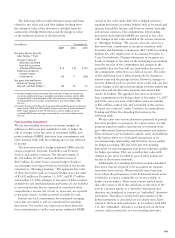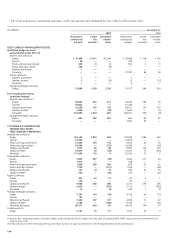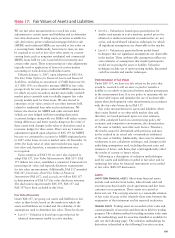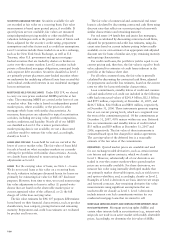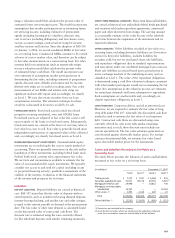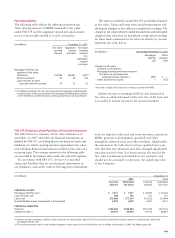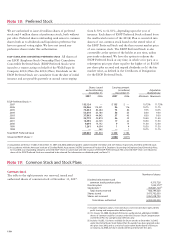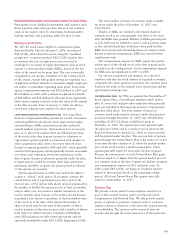Wells Fargo 2007 Annual Report Download - page 104
Download and view the complete annual report
Please find page 104 of the 2007 Wells Fargo annual report below. You can navigate through the pages in the report by either clicking on the pages listed below, or by using the keyword search tool below to find specific information within the annual report.
101
Our approach to managing interest rate risk includes the
use of derivatives. This helps minimize significant, unplanned
fluctuations in earnings, fair values of assets and liabilities,
and cash flows caused by interest rate volatility. This
approach involves modifying the repricing characteristics of
certain assets and liabilities so that changes in interest rates
do not have a significant adverse effect on the net interest
margin and cash flows. As a result of interest rate fluctuations,
hedged assets and liabilities will gain or lose market value.
In a fair value hedging strategy, the effect of this unrealized
gain or loss will generally be offset by the gain or loss on the
derivatives linked to the hedged assets and liabilities. In a
cash flow hedging strategy, we manage the variability of cash
payments due to interest rate fluctuations by the effective use
of derivatives linked to hedged assets and liabilities.
We use derivatives as part of our interest rate risk
management, including interest rate swaps, caps and floors,
futures and forward contracts, and options. We also offer
various derivatives, including interest rate, commodity, equity,
credit and foreign exchange contracts, to our customers but
usually offset our exposure from such contracts by purchasing
other financial contracts. The customer accommodations and
any offsetting financial contracts are treated as free-standing
derivatives. Free-standing derivatives also include derivatives
we enter into for risk management that do not otherwise
qualify for hedge accounting, including economic hedge
derivatives. To a lesser extent, we take positions based on
market expectations or to benefit from price differentials
between financial instruments and markets. Additionally,
free-standing derivatives include embedded derivatives
that are required to be separately accounted for from their
host contracts.
By using derivatives, we are exposed to credit risk if
counterparties to financial instruments do not perform as
expected. If a counterparty fails to perform, our credit risk
is equal to the fair value gain in a derivative contract. We
minimize credit risk through credit approvals, limits and
monitoring procedures. Credit risk related to derivatives is
considered and, if material, provided for separately. As we
generally enter into transactions only with counterparties
that carry high quality credit ratings, losses from counterparty
nonperformance on derivatives have not been significant.
Further, we obtain collateral, where appropriate, to reduce
risk. To the extent the master netting arrangements and
other criteria meet the requirements of FASB Interpretation
No. 39, Offsetting of Amounts Related to Certain Contracts,
as amended by FASB Interpretation No. 41, Offsetting
of Amounts Related to Certain Repurchase and Reverse
Repurchase Agreements, amounts are shown net in the
balance sheet.
Our derivative activities are monitored by Corporate
ALCO. Our Treasury function, which includes asset/liability
management, is responsible for various hedging strategies
developed through analysis of data from financial models
and other internal and industry sources. We incorporate the
resulting hedging strategies into our overall interest rate risk
management and trading strategies.
Fair Value Hedges
Prior to January 1, 2006, we used derivatives as fair value
hedges to manage the risk of changes in the fair value of
residential MSRs and other interests held. These derivatives
included interest rate swaps, swaptions, Eurodollar and
Treasury futures and options, and forward contracts.
Derivative gains or losses caused by market conditions
(volatility) and the spread between spot and forward rates
priced into the derivative contracts (the passage of time)
were excluded from the evaluation of hedge effectiveness,
but were reflected in earnings. Upon adoption of FAS 156,
derivatives used to hedge our residential MSRs are no longer
accounted for as fair value hedges under FAS 133, but as
economic hedges. Net derivative gains and losses related to
our residential mortgage servicing activities are included in
“Servicing income, net” in Note 9.
We use interest rate swaps to convert certain of our fixed-
rate long-term debt and certificates of deposit to floating
rates to hedge our exposure to interest rate risk. We also
enter into cross-currency swaps and cross-currency interest
rate swaps to hedge our exposure to foreign currency risk
and interest rate risk associated with the issuance of non-
U.S. dollar denominated long-term debt. Prior to January 1,
2007, the ineffective portion of these fair value hedges was
recorded as part of interest expense in the income statement.
Subsequent to January 1, 2007, the ineffective portion of
Note 16: Derivatives
predecessors (collectively Visa) and certain other member
banks of the Visa USA network, (2) litigation, and (3) an
escrow account that will be established by Visa Inc. at the
time of its IPO. The escrow account will be funded from IPO
proceeds and will be used to make payments related to Visa
litigation. We recorded litigation liabilities associated with
indemnification obligations related to agreements entered
into during second quarter 2006 and third quarter 2007.
Based on our proportionate membership share of Visa USA,
we recorded a litigation liability and corresponding expense
of $95 million for 2006 and $203 million for 2007. The
effect to the second quarter 2006 was estimated based
upon our share of an actual settlement reached in November
2007. Management does not believe that the fair value of
this obligation if determined in second quarter 2006 would
have been materially different given information available
at that time. Management has concluded, and the Audit
and Examination Committee of our Board of Directors
has concurred, that these amounts are immaterial to the
periods affected.




